*NURSING > QUESTIONS & ANSWERS > PN Hesi Exit new exam questions and answers mostly tested exam questions new docs 2020 chamberlain c (All)
PN Hesi Exit new exam questions and answers mostly tested exam questions new docs 2020 chamberlain collage
Document Content and Description Below
PN Hesi Exit new exam questions and answers mostly tested exam questions new docs 2020 1) The LPN/LVN is preparing to ambulate a postoperative client after cardiac surgery. The nurse plans to do... which to enable the client to best tolerate the ambulation? 1. Provide the client with a walker. 2. Remove the telemetry equipment. 3. Encourage the client to cough and deep breathe. 4. Premedicate the client with an analgesic before ambulating. 2) A client is wearing a continuous cardiac monitor, which begins to alarm at the nurse's station. The nurse sees no electrocardiographic complexes on the screen. The nurse should do which first? 1. Call a code blue. 2. Call the health care provider. 3. Check the client status and lead placement. 4. Press the recorder button on the ECG console. 3) The LPN/LVN in a medical unit is caring for a client with heart failure. The client suddenly develops extreme dyspnea, tachycardia, and lung crackles, and the nurse suspects pulmonary edema. The nurse immediately notifies the registered nurse and expects which interventions to be prescribed? Select all that apply. 1. Administering oxygen 2. Inserting a Foley catheter 3. Administering furosemide (Lasix) 4. Administering morphine sulfate intravenously 5. Transporting the client to the coronary care unit 6. Placing the client in a low-Fowler's side-lying position 4) The nurse is monitoring a client following cardioversion. Which observations should be of highest priority to the nurse? 1. Blood pressure 2. Status of airway 3. Oxygen flow rate 4. Level of consciousness 5) The nurse is assisting in caring for the client immediately after insertion of a permanent demand pacemaker via the right subclavian vein. The nurse prevents dislodgement of the pacing catheter by implementing which intervention? 1. Limiting movement and abduction of the left arm 2. Limiting movement and abduction of the right arm 3. Assisting the client to get out of bed and ambulate with a walker 4. Having the physical therapist do active range of motion to the right arm 6) A client diagnosed with thrombophlebitis 1 day ago suddenly complains of chest pain and shortness of breath, and the client is visibly anxious. The LPN/LVN understands that a life-threatening complication of this condition is which? 1. Pneumonia 2. Pulmonary edema 3. Pulmonary embolism 4. Myocardial infarction 7) A 24-year-old man seeks medical attention for complaints of claudication in the arch of the foot. The nurse also notes superficial thrombophlebitis of the lower leg. The nurse should check the client for which next? 1. Smoking history 2. Recent exposure to allergens 3. History of recent insect bites 4. Familial tendency toward peripheral vascular disease 8) The nurse has reinforced instructions to the client with Raynaud's disease about self-management of the disease process. The nurse determines that the client needs further teaching if the client states which? 1. "Smoking cessation is very important." 2. "Moving to a warmer climate should help." 3. "Sources of caffeine should be eliminated from the diet." 4. "Taking nifedipine (Procardia) as prescribed will decrease vessel spasm." 9) A client with myocardial infarction suddenly becomes tachycardic, shows signs of air hunger, and begins coughing frothy, pink-tinged sputum. The nurse listens to breath sounds, expecting to hear which breath sounds bilaterally? 1. Rhonchi 2. Crackles 3. Wheezes 4. Diminished breath sounds 10) The LPN/LVN is collecting data on a client with a diagnosis of right- sided heart failure. The nurse should expect to note which specific characteristic of this condition? 1. Dyspnea 2. Hacking cough 3. Dependent edema 4. Crackles on lung auscultation 11) The LPN/LVN is checking the neurovascular status of a client who returned to the surgical nursing unit 4 hours ago after undergoing an aortoiliac bypass graft. The affected leg is warm, and the nurse notes redness and edema. The pedal pulse is palpable and unchanged from admission. The nurse interprets that the neurovascular status is which? 1. Moderately impaired, and the surgeon should be called 2. Normal, caused by increased blood flow through the leg 3. Slightly deteriorating, and should be monitored for another hour 4. Adequate from an arterial approach, but venous complications are arising 12) A client with a diagnosis of rapid rate atrial fibrillation asks the nurse why the health care provider is going to perform carotid massage. The LPN/LVN responds that this procedure may stimulate which? 1. Vagus nerve to slow the heart rate 2. Vagus nerve to increase the heart rate 3. Diaphragmatic nerve to slow the heart rate 4. Diaphragmatic nerve to increase the heart rate 13) A client is admitted to the hospital with possible rheumatic endocarditis. The LPN/LVN should check for a history of which type of infection? 1. Viral infection 2. Yeast infection 3. Streptococcal infection 4. Staphylococcal infection 14) A client has an Unna boot applied for treatment of a venous stasis leg ulcer. The LPN/LVN notes that the client's toes are mottled, and cool and the client verbalizes some numbness and tingling of the foot. Which interpretation should the nurse make of these findings? 1. The boot has not yet dried. 2. The boot is controlling leg edema. 3. The boot is impairing venous return. 4. The boot has been applied too tightly. 15) A client with angina complains that the anginal pain is prolonged and severe and occurs at the same time each day, most often in the morning. On further data collection, the nurse notes that the pain occurs in the absence of precipitating factors. How should the LPN/LVN best describe this type of anginal pain? 1. Stable angina 2. Variant angina 3. Unstable angina 4. Nonanginal pain 16) The LPN/LVN is monitoring a client with an abdominal aortic aneurysm (AAA). Which finding is probably unrelated to the AAA? 1. Pulsatile abdominal mass 2. Hyperactive bowel sounds in the area 3. Systolic bruit over the area of the mass 4. Subjective sensation of "heart beating" in the abdomen 17) An emergency department client who complains of slightly improved but unrelieved chest pain for 2 days is reluctant to take a nitroglycerin sublingual tablet offered by the nurse. The client states, "I don't need that—my dad takes that for his heart. There's nothing wrong with my heart." Which description best describes the client's response? 1. Angry 2. Denial 3. Phobic 4. Obsessive-compulsive 18) A client is scheduled for a cardiac catheterization using a radiopaque dye. The LPN/LVN checks which most critical item before the procedure? 1. Intake and output 2. Height and weight 3. Peripheral pulse rates 4. Prior reaction to contrast media 19) A client is scheduled for a dipyridamole thallium scan. The LPN/ LVN should check to make sure that the client has not consumed which substance before the procedure? 1. Caffeine 2. Fatty meal 3. Excess sugar 4. Milk products 20) An ambulatory clinic nurse is interviewing a client who is complaining of flulike symptoms. The client suddenly develops chest pain. Which question best assists the nurse to discriminate pain caused by a non cardiac problem? 1. "Can you describe the pain to me?" 2. "Have you ever had this pain before?" 3. "Does the pain get worse when you breathe in?" 4. "Can you rate the pain on a scale of 1 to 10, with 10 being the worst?" 21) A client with myocardial infarction (MI) has been transferred from the coronary care unit (CCU) to the general medical unit with cardiac monitoring via telemetry. The nurse assisting in caring for the client expects to note which type of activity prescribed? 1. Strict bed rest for 24 hours 2. Bathroom privileges and self-care activities 3. Unrestricted activities because the client is monitored 4. Unsupervised hallway ambulation with distances less than 200 feet 22) The LPN/LVN is preparing to care for a client who will be arriving from the recovery room after an above-the-knee amputation. The nurse ensures that which priority item is available for emergency use? 1. Surgical tourniquet 2. Dry sterile dressings 3. Incentive spirometer 4. Over-the-bed trapeze 23) A client is diagnosed with thrombophlebitis. The nurse should tell the client that which prescription is indicated? 1. Bed rest, with bathroom privileges only 2. Bed rest, keeping the affected extremity flat 3. Bed rest, with elevation of the affected extremity 4. Bed rest, with the affected extremity in a dependent position 24) A client returns to the nursing unit after an above knee amputation of the right leg. In which position should the nurse place the client? 1. Prone with the head on a pillow 2. With the foot of the bed elevated 3. Reverse Trendelenburg's position 4. With the residual limb flat on the bed 25) The LPN/LVN is collecting data from a client about medications being taken, and the client tells the nurse that he is taking herbal supplements for the treatment of varicose veins. The nurse understands that the client is most likely taking which? 1. Bilberry 2. Ginseng 3. Feverfew 4. Evening primrose 26) The LPN/LVN is planning to reinforce instructions to a client with peripheral arterial disease about measures to limit disease progression. The nurse should include which items on a list of suggestions to be given to the client? Select all that apply. 1. Wear elastic stockings. 2. Be careful not to injure the legs or feet. 3. Use a heating pad on the legs to aid vasodilation. 4. Walk each day to increase circulation to the legs. 5. Cut down on the amount of fats consumed in the diet. 27) A client is at risk for developing disseminated intravascular coagulopathy (DIC). The LPN/LVN should become concerned with which fibrinogen level? 1. 90 mg/dL 2. 190 mg/dL 3. 290 mg/dL 4. 390 mg/dL 28) A hospitalized client with a history of angina pectoris is ambulating in the corridor. The client suddenly complains of severe substernal chest pain. The LPN/LVN should take which action first? 1. Check the client's vital signs. 2. Assist the client to sit or lie down. 3. Administer sublingual nitroglycerin. 4. Apply nasal oxygen at a rate of 2 L/min. 29) The LPN/LVN notes bilateral 2+ edema in the lower extremities of a client with known coronary artery disease who was admitted to the hospital 2 days ago. Based on this finding, the nurse should implement which action? 1. Reviews the intake and output records for the last 2 days 2. Prescribes daily weights starting on the following morning 3. Changes the time of diuretic administration from morning to evening 4. Requests a sodium restriction of 1 g/day from the health care provider 30) A client brings the following medications to the clinic for a yearly physical. The LPN/LVN realizes which medication has been prescribed to treat heart failure? 1. Digoxin (Lanoxin) 2. Warfarin (Coumadin) 3. Amiodarone (Cordarone) 4. Potassium chloride (K-Dur) 31) A student nurse is assigned to assist in caring for a client with acute pulmonary edema who is receiving digoxin (Lanoxin) and heparin therapy. The nursing instructor reviews the plan of care formulated by the student and tells the student that which intervention is unsafe? 1. Restricting the client's potassium intake 2. Encouraging the client to rest after meals 3. Administering the heparin with a 25-gauge needle 4. Holding the digoxin for a heart rate less than 60 beats per minute 32) A client has an inoperable abdominal aortic aneurysm (AAA). Which measure should the nurse anticipate reinforcing when teaching the client? 1. Bed rest 2. Restricting fluids 3. Antihypertensives 4. Maintaining a low-fiber diet 33) The LPN/LVN finds a client tensing while lying in bed staring at the cardiac monitor. Which is the nurse's best response when the client states, "There sure are a lot of wires around there. I sure hope we don't get hit by lightning!"? 1. "Would you like a mild sedative to help you relax?" 2. "Oh, don't worry, the weather is supposed to be sunny and clear today." 3. "Yes, this equipment is a little scary. Can we talk about how the cardiac monitor works?" 4. "I can appreciate your concerns. Your family can stay with you tonight if you want them to." 34) The LPN/LVN is asked to assist another health care member in providing care to a client who is placed in a modified Trendelenburg's position. The nurse interprets that the client is likely being treated for which condition? 1. Shock 2. Kidney dysfunction 3. Respiratory insufficiency 4. Increased intracranial pressure 35) A client is seen in the health care provider's office for a physical examination after experiencing unusual fatigue over the last several weeks. Height is 5 feet, 8 inches, with a weight of 220 pounds. Vital signs are temperature 98.6° F oral, pulse 86 beats per minute, respirations 18 breaths per minute, and blood pressure 184/96 mm Hg. Random blood glucose is 110 mg/dL. In order to best collect relevant data, which question should the LPN/LVN ask the client first? 1. "Do you exercise regularly?" 2. "Would you consider losing weight?" 3. "Is there a history of diabetes mellitus in your family?" 4. "When was the last time you had your blood pressure checked?" 36) The client scheduled for a right femoropopliteal bypass graft is at risk for compromised tissue perfusion to the extremity. The LPN/LVN takes which action before surgery to address this risk? 1. Having the client void before surgery 2. Completing a preoperative checklist 3. Marking the location of the pedal pulses on the right leg 4. Checking the results of any baseline coagulation studies 37) When preparing a client for a pericardiocentesis, which position does the LPN/LVN place the client in? 1. Supine with slight lowering of the head 2. Lying on the right side with a pillow under the head 3. Lying on the left side with a pillow under the chest wall 4. Supine with the head of bed elevated at a 45- to 60-degree angle 38) For a client diagnosed with pulmonary edema, the LPN/LVN establishes a goal to have the client participate in activities that reduce cardiac workload. Which client activities will contribute to achieving this goal? 1. Elevating the legs when in bed 2. Sleeping in the supine position 3. Using a bedside commode for stools 4. Seasoning beef with a meat tenderizer 39) The LPN/LVN is caring for a client who is developing pulmonary edema. The client exhibits respiratory distress, but the blood pressure is unchanged from the client's baseline. As an immediate action before help arrives, the nurse should perform which action? 1. Suction the client vigorously. 2. Place the client in high-Fowler's position. 3. Begin assembling medications that are anticipated to be given. 4. Call the respiratory therapy department to request a ventilator. 40) The LPN/LVN has reinforced home care instructions to a client who had a permanent pacemaker inserted. Which educational outcome has the greatest impact on the client's long-term cardiac health? 1. Knowledge of when it is safe to resume sexual activity 2. The ability to take an accurate pulse in either the wrist or neck 3. An understanding of the importance of proper microwave oven usage 4. An understanding of why vigorous arm and shoulder movement must be avoided initially 41) The clinic nurse is obtaining cardiovascular data on a client. The LPN/LVN prepares to check the client's apical pulse and places the stethoscope in which position? 1. Midsternum equal with the nipple line 2. At the midaxillary line on the left side of the chest 3. At the midline of the chest just below the xiphoid process 4. At the midclavicular line at the fifth left intercostal space 42) The LPN/LVN is caring for a client who has been admitted to the hospital with a diagnosis of angina pectoris. The client is receiving oxygen via nasal cannula at 2 L. The client asks the nurse why the oxygen is necessary. The LPN/LVN bases the response on which information? 1. Oxygen assists in calming the client. 2. Oxygen prevents the development of any thrombus formation. 3. Deficient oxygenation to heart cells results in angina pectoris pain. 4. Oxygen dilates the blood vessels, supplying more nutrients to the heart muscle. 43) The licensed practical nurse (LPN) is assisting in caring for a client with a diagnosis of myocardial infarction (MI). The client is experiencing chest pain that is unrelieved by the administration of nitroglycerin. The registered nurse administers morphine sulfate to the client as prescribed by the health care provider. Following administration of the morphine sulfate, the LPN plans to monitor which indicator(s)? 1. Mental status 2. Urinary output 3. Respirations and blood pressure 4. Temperature and blood pressure 44) A client diagnosed with angina pectoris returns to the nursing unit after experiencing an angioplasty. The nurse reinforces instructions to the client regarding the procedure and home care measures. Which statement by the client indicates an understanding of the instructions? 1. "I am considering cutting my workload." 2. "I need to cut down on cigarette smoking." 3. "I am so relieved that my heart is repaired." 4. "I need to adhere to my dietary restrictions." 45) The LPN/LVN is caring for a client with a diagnosis of myocardial infarction (MI) and is assisting the client in completing the diet menu. Which beverage does the nurse instruct the client to select from the menu? 1. Tea 2. Cola 3. Coffee 4. Lemonade 46) The LPN/LVN is collecting data on a client with a diagnosis of angina pectoris who takes nitroglycerin for chest pain. During the admission, the client reports chest pain. The nurse immediately asks the client which question? 1. "Are you having any nausea?" 2. "Where is the pain located?" 3. "Are you allergic to any medications?" 4. "Do you have your nitroglycerin with you?" 47) The LPN/LVN has reinforced dietary instructions to a client with coronary artery disease. Which statement by the client indicates an understanding of the dietary instructions? 1. "I need to substitute eggs and milk for meat." 2. "I will eliminate all cholesterol and fat from my diet." 3. "I should routinely use polyunsaturated oils in my diet." 4. "I need to seriously consider becoming a strict vegetarian." 48) The LPN/LVN is assisting in caring for a client in the telemetry unit who is receiving an intravenous infusion of 1000 mL 5% dextrose with 40 mEq of potassium chloride. Which occurrence observed on the cardiac monitor indicates the presence of hyperkalemia? 1. Tall, peaked T waves 2. ST segment depressions 3. Shortened P-R intervals 4. Shortening of the QRS complex 49) The LPN/LVN is assisting in caring for a client in the telemetry unit and is monitoring the client for cardiac changes indicative of hypokalemia. Which occurrence noted on the cardiac monitor indicates the presence of hypokalemia? 1. Tall, peaked T waves 2. ST-segment depression 3. Prolonged P-R interval 4. Widening of the QRS complex 50) While the nurse is involved in preparing a client for a cardiac catheterization, the client says, "I don't want to talk with you. You're only the nurse. I want my doctor." Which response by the nurse should be therapeutic? 1. "Your doctor expects me to prepare you for this procedure." 2. "That's fine, if that's what you want. I'll call your health care provider." 3. "So you're saying that you want to talk to your health care provider?" 4. "I'm concerned with the way you've dismissed me. I know what I am doing." 51) The LPN/LVN reinforces instructions to a client at risk for thrombophlebitis regarding measures to minimize its occurrence. Which statement by the client indicates an understanding of this information? 1. "I need to avoid pregnancy by taking oral contraceptives." 2. "I should avoid sitting in one position for long periods of time." 3. "I can finally stop wearing these support stockings that you gave me." 4. "I will be sure to maintain my fluid intake to at least four glasses daily." 52) A client with a history of angina pectoris tells the nurse that chest pain usually occurs after going up two flights of stairs or after walking four blocks. The LPN/LVN interprets that the client is experiencing which type of angina? 1. Stable 2. Variant 3. Unstable 4. Intractable 53) The LPN/LVN is teaching the client with angina pectoris about disease management and lifestyle changes that are necessary in order to control disease progression. Which statement by the client indicates a need for further teaching? 1. "I will avoid using table salt with meals." 2. "It is best to exercise once a week for an hour." 3. "I will take nitroglycerin whenever chest discomfort begins." 4. "I will use muscle relaxation to cope with stressful situations." 54) The LPN/LVN is working with a client who has been diagnosed with Prinzmetal's (variant) angina. The nurse plans to reinforce which information about this type of angina when teaching the client? 1. Prinzmetal's angina is effectively managed by beta-blocking agents. 2. Prinzmetal's angina improves with a low-sodium, high-potassium diet. 3. Prinzmetal's angina has the same risk factors as stable and unstable angina. 4. Prinzmetal's angina is generally treated with calcium channel blocking agents. 55) The LPN/LVN working in a long-term care facility is collecting data from a client experiencing chest pain. The nurse should interpret that the pain is likely a result of myocardial infarction (MI) if which observation is made by the nurse? 1. The client is not experiencing nausea or vomiting. 2. The pain is described as substernal and radiating to the left arm. 3. The pain has not been unrelieved by rest and nitroglycerin tablets. 4. The client says the pain began while trying to open a stuck dresser drawer. 56) The LPN/LVN is discussing smoking cessation with a client diagnosed with coronary artery disease (CAD). Which statement should the nurse make to the client to try to motivate the client to quit smoking? 1. "Since the damage has already been done, it will be all right to cut down a little at a time." 2. "None of the cardiovascular effects are reversible, but quitting might prevent lung cancer." 3. "If you totally quit smoking right now, you can cut your cardiovascular risk to zero within a year." 4. "If you quit now, your risk of cardiovascular disease will decrease to that of a nonsmoker in 3 to 4 years." 57) A client with heart failure is scheduled to be discharged to home with digoxin (Lanoxin) and furosemide (Lasix) as ongoing prescribed medications. The nurse teaches the client to report which sign/symptom that indicates the medications are not producing the intended effect? 1. Decrease in pedal edema 2. High urine output during the day 3. Weight gain of 2 to 3 pounds in a few days 4. Cough accompanied by other signs of respiratory infection 58) A client has experienced an episode of pulmonary edema. The LPN/ LVN determines that the client's respiratory status is improving if which breath sounds are noted? 1. Rhonchi 2. Wheezes 3. Crackles in the lung bases 4. Crackles throughout the lung fields 3. Crackles in the lung bases 59) A client in pulmonary edema has a prescription to receive morphine sulfate intravenously. The licensed practical nurse assisting in caring for the client determines that the client experienced an intended effect of the medication if which is noted? 1. Increased pulse rate 2. Relief of apprehension 3. Decreased urine output 4. Increased blood pressure 60) The LPN/LVN is providing discharge teaching for a post-myocardial infarction (MI) client who will be taking 1 baby aspirin a day. The nurse determines that the client understands the use of this medication if the client makes which statement? 1. "I will take this medication every day." 2. "I will take this medication every other day." 3. "I will take this medication until I feel better." 4. "I will take this medication only when I have pain." 61) The LPN/LVN determines that a client with coronary artery disease (CAD) needs further teaching about disease management if the client makes which statement? 1. "I will watch my weight gain." 2. "I will avoid walking for exercise." 3. "I will monitor my cholesterol intake." 4. "I will follow a low-fat, low-salt diet." 62) An older client with ischemic heart disease has experienced an episode of dizziness and shortness of breath. The nurse reviews the plan of care and notices documentation of decreased cardiac output, dyspnea, and syncopal episodes. The nurse plans to take which important action? 1. Monitor oxygen saturation levels. 2. Place the client on a cardiac monitor. 3. Measure blood pressure every 4 hours. 4. Check capillary refill at least once per shift. 63) The LPN/LVN is planning adaptations needed for activities of daily living for a client with cardiac disease. The nurse should incorporate which instruction in discussion with the client? 1. Increase fluids to 3000 mL per day to promote renal perfusion. 2. Consume 1 to 2 oz of liquor each night to promote vasodilation. 3. Try to engage in vigorous activity to strengthen cardiac reserve. 4. Take in adequate daily fiber to prevent straining during a bowel movement. 64) An adult client just admitted to the hospital with heart failure also has a history of diabetes mellitus. The nurse calls the health care provider to verify a prescription for which medication that the client was taking before admission? 1. NPH insulin 2. Regular insulin 3. Chlorpropamide 4. Acarbose (Precose) 65) Acetylsalicylic acid (aspirin) is prescribed for a client before a percutaneous transluminal coronary angioplasty (PTCA). When the nurse takes the aspirin to the client, the client asks the nurse about its purpose. What is the purpose of the aspirin? 1. To prevent the formation of clots 2. To relieve pain at the injection site 3. To prevent a fever after the procedure 4. To prevent inflammation of the injection site 66) The nurse is caring for a client with coronary artery disease, and a topical nitrate is prescribed for the client. Why is acetaminophen (Tylenol) usually prescribed to be taken before the administration of the topical nitrate? 1. Headache is a common side effect of nitrates. 2. Fever usually accompanies coronary artery disease. 3. Acetaminophen potentiates the therapeutic effects of nitrates. 4. Acetaminophen does not interfere with platelet action as acetylsalicylic acid (aspirin) does. 67) The nurse is assisting in developing a plan of care for a client who will be returning to the nursing unit following a cardiac catheterization via the femoral approach. Which nursing intervention should be included in the postprocedure plan of care? 1. Place the client's bed in the Fowler's position. 2. Encourage the client to increase fluid intake. 3. Instruct the client to perform range-of-motion exercises of the extremities. 4. Hold regularly scheduled medications for 24 hours following the procedure. 68) The nurse is reinforcing dietary instructions to a client with heart failure (HF). The nurse determines that the client understands the instructions if the client states that which food item will be avoided? 1. Catsup 2. Sherbet 3. Cooked cereal 4. Leafy green vegetables 69) A client seeks medical attention for intermittent episodes in which the fingers of both hands become cold, pale, and numb. The client states that they then become reddened and swollen with a throbbing, achy pain and Raynaud's disease is diagnosed. Which factor would precipitate these episodes? 1. Exposure to heat 2. Being in a relaxed environment 3. Prolonged episodes of inactivity 4. Ingestion of coffee or chocolate 70) A client is admitted to the hospital with a diagnosis of pericarditis. The nurse reviews the client's record for which sign or symptom that differentiates pericarditis from other cardiopulmonary problems? 1. Anterior chest pain 2. Pericardial friction rub 3. Weakness and irritability 4. Chest pain that worsens on inspiration 71) The nurse is beginning to ambulate a client with activity intolerance caused by bacterial endocarditis. The nurse determines that the client is best tolerating ambulation if which parameter is noted? 1. Mild dyspnea after walking 10 feet 2. Minimal chest pain rated 1 on a 1-to-10 pain scale 3. Pulse rate that increases from 68 to 94 beats per minute 4. Blood pressure that increases from 114/82 to 118/86 mm Hg 72) The nurse is assisting a hospitalized client who is newly diagnosed with coronary artery disease (CAD) to make appropriate selections from the dietary menu. The nurse encourages the client to select which meal? 1. Sausage, pancakes, and toast 2. Broccoli, buttered rice, and grilled chicken 3. Hamburger, baked apples, and avocado salad 4. Fresh strawberries, steamed vegetables, and baked fish 73) A client with known coronary artery disease (CAD) begins to experience chest pain while getting out of bed. The nurse should take which action? 1. Get a prescription for pain medication. 2. Have the client stop and lie back down in bed. 3. Report the complaint to the health care provider. 4. Have the client continue to get out of bed and into a chair. 74) The nurse is setting up the bedside unit for a client being admitted to the nursing unit from the emergency department with a diagnosis of coronary artery disease (CAD). The nurse should place highest priority on making sure that which is available at the bedside? 1. Bedside commode 2. Rolling shower chair 3. Oxygen tubing and flowmeter 4. Twelve-lead electrocardiogram (ECG) machine 75) The nurse determines that a client with coronary artery disease (CAD) understands disease management if the client makes which statement? 1. "I will walk for one-half hour daily." 2. "As long as I exercise I can eat anything I wish." 3. "My weight has nothing to do with this disease." 4. "It doesn't matter if my father had high cholesterol." 76) A client has just completed an information session about measures to minimize the progression of coronary artery disease (CAD). Which statement indicates an initial understanding of lifestyle alterations? 1. I should take daily medication for life. 2. I should eat a diet that is low in fat and cholesterol. 3. I should continue to smoke to keep the metabolic rate high. 4. I should begin to exercise if diet is not sufficient to achieve weight loss. 77) The nurse is collecting data on a client who was just admitted to the hospital with a diagnosis of coronary artery disease (CAD). The client reveals having been under a great deal of stress recently. Which should the nurse do next? 1. Ask whether the client wants to see a psychiatrist. 2. Explore with the client the sources of stress in life. 3. Reassure the client that everybody seems stressed these days. 4. Ask the client to write down a list of stressors to be evaluated at a later time. 78) A client with a diagnosis of myocardial infarction has a new activity prescription allowing the client to have bathroom privileges. As the client stands and begins to walk, the client begins to complain of chest pain. The nurse should take which action? 1. Assist the client to get back into bed. 2. Report the chest pain episode to the health care provider. 3. Tell the client to stand still, and take the client's blood pressure. 4. Give a nitroglycerin (Nitrostat) tablet, and assist the client to the bathroom. 79) A client being seen in the emergency department for complaints of chest pain confides in the nurse about regular use of cocaine as a recreational drug. The nurse takes which important action in delivering holistic nursing care to this client? 1. Reports the client to the police for illegal drug use 2. Explains to the client the damage that cocaine does to the heart 3. Tells the client it is imperative to stop before myocardial infarction occurs 4. Teaches about the effects of cocaine on the heart and offers referral for further help 80) The nurse is planning measures to decrease the incidence of chest pain for a client with angina pectoris. The nurse should do which intervention to effectively accomplish this goal? 1. Provide a quiet and low-stimulus environment. 2. Encourage the family to come visit very frequently. 3. Encourage the client to call friends and relatives each day. 4. Recommend that the client watch TV as a constant diversion. 81) A client in a long-term care facility who has a history of angina pectoris wants to go for a short walk outside with a family member. It is a sunny but chilly December day. The nurse should perform which intervention to care for this client in a holistic manner? 1. Tell the client that this is not allowed. 2. Tell the family member not to take the client outdoors. 3. Give the client a cup of hot coffee before going outside. 4. Instruct the family member to dress the client warmly before going outside. 82) The LPN/LVN carries out a standard prescription for a stat electrocardiogram (ECG) on a client who has an episode of chest pain. The nurse should take which action next? 1. Do a repeat 12-lead ECG. 2. Wait to see whether the pain resolves. 3. Report the episode of chest pain to the health care provider. 4. Give sublingual nitroglycerin (Nitrostat) per the health care provider's prescriptions. 83) A client admitted to the hospital with a diagnosis of myocardial infarction (MI) tells the nurse that the pain likely resulted from the fried chicken sandwich that the client had for lunch. The nurse's response is based on which fact? 1. Most people love high-fat diets. 2. Denial is a common occurrence early after MI. 3. The client probably wants to belittle the opinion of the staff. 4. The client is not motivated to learn about heart disease at this time. 84) The nurse is preparing to provide a therapeutic environment for a client who recently had a myocardial infarction (MI). Which are characteristics of a therapeutic environment? 1. No stimulus, no stress 2. Low stimulus, low stress 3. High stimulus, low stress 4. Moderate stimulus, low stress 85) A client who experienced a myocardial infarction (MI) tells the nurse that he is fearful about not being able to return to a normal life. Which action by the nurse is therapeutic at this time? 1. Tell the client that his fears are not rational. 2. Tell the client that his life has not changed. 3. Explore the specific concerns with the client. 4. Tell the client to talk it out with the significant other. 86) A client complaining of chest pain has an as-needed (PRN) prescription for sublingual nitroglycerin (Nitrostat). Before administering the medication to the client, the nurse should first check which? 1. Blood pressure 2. Cardiac rhythm 3. Respiratory rate 4. Peripheral pulses 87) A client who has undergone femoropopliteal bypass grafting says to the nurse, "I hope I don't have any more problems that could make me lose my leg. I'm so afraid that I'll have gone through this for nothing." Which is an appropriate nursing response? 1. "There is nothing to worry about." 2. "You are concerned about losing your leg?" 3. "There are many people with the same problem, and they are doing just fine." 4. "You have the best health care provider in the city, and your health care provider will not let anything happen to you." 88) The nurse is teaching a hospitalized client who has had aortoiliac bypass grafting about measures to improve circulation. The nurse should tell the client to do which? 1. Bend the leg at the hip. 2. Keep the ankles uncrossed. 3. Place two pillows under the knees. 4. Use the knee gatch on the bed controls. 89) A client is admitted to the hospital with possible rheumatic heart disease. The LPN/LVN collects data from the client and checks the client for which signs/symptoms? 1. Skin scratches 2. Vaginal itching 3. Fever and sore throat 4. Burning on urination 90) A client with infective endocarditis is at risk for heart failure. The nurse monitors the client for which signs and symptoms of heart failure? 1. Lung crackles, peripheral edema, and weight gain 2. Confusion, decreasing level of consciousness, and aphasia 3. Respiratory distress, chest pain, and the use of accessory muscles 4. Flank pain with radiation to the groin, accompanied by hematuria 91) A client has just returned from the cardiac catheterization laboratory. The left femoral vessel was used as the access site. After returning the client to bed and conducting an initial assessment, the nurse assisting in caring for the client expects the health care provider to write a prescription for the client to remain on bed rest. In which position should the bed be positioned? 1. In the high-Fowler's position 2. With the head of bed elevated at least 60 degrees 3. With the head of bed elevated no more than 30 degrees 4. With the foot of bed elevated as much as tolerated by the client 92) The nurse is collecting data from a client with varicose veins. Which finding would the nurse identify as an indication of a potential complication associated with this disorder? 1. Legs are unsightly in appearance and distress the client. 2. The client complains of aching and feelings of heaviness in the legs. 3. The client complains of leg edema, and skin breakdown has started. 4. The health care provider finds that the legs become distended when the tourniquet is released during the Trendelenburg's test. 93) A client with coronary artery disease has selected guided imagery to help cope with psychological stress. Which statement by the client indicates understanding of this stress reduction measure? 1. "This will help only if I play music at the same time." 2. "This will work for me only if I am alone in a quiet area." 3. "I need to do this only when I lie down in case I fall asleep." 4. "The best thing about this is that I can use it anywhere, anytime." 94) A client, who is 36 hours post-myocardial infarction, has ambulated for the first time. The nurse determines that the client best tolerated the activity if which observation is made? 1. The skin is cool but slightly diaphoretic. 2. Dyspnea is noted only at the end of the exercise. 3. The pre activity pulse rate is 86 beats per minute; the post activity pulse rate is 94 beats per minute. 4. The pre activity blood pressure (BP) is 140/84 mm Hg; the post activity BP is 110/72 mm Hg. 95) The nurse is planning a dietary menu for a client with heart failure being treated with digoxin (Lanoxin) and furosemide (Lasix). Which would be the best dinner choice from the daily menu? 1. Beef ravioli, spinach soufflé, and Italian bread 2. Baked pollock, mashed potatoes, and carrot-raisin salad 3. Roasted chicken breast, brown rice, and stewed tomatoes 4. Beef vegetable soup, macaroni and cheese, and a dinner roll 96) A client has received instructions about an upcoming cardiac catheterization. The nurse determines that the client has the best understanding of the procedure if the client knows to report which symptoms? 1. Chest pain 2. Urge to cough 3. Warm, flushed feeling 4. Pressure at the insertion site 97) The nurse is caring for a client diagnosed with Buerger's disease. Which finding should the nurse determine is a potential complication associated with this disease? 1. Pain with diaphoresis 2. Discomfort in one digit 3. Numbness and tingling in the legs 4. Cramping in the foot while resting 98) The nurse has completed nutritional counseling with an overweight client about weight reduction to modify the risk for coronary artery disease (CAD). The nurse should determine the teaching is successful if the client states that which weight loss goal is safe? 1. One half pound per day 2. Two pounds per week 3. Four pounds per week 4. Six pounds per week 99) The nurse has reinforced instructions to the family of an older client who seems anxious about being discharged after cardiac surgery. The nurse understands further teaching is needed if a family member makes which statement? 1. "Recuperation after cardiac surgery is generally slower for older people." 2. "It's important to get out of bed every day, even if tired or weak at first." 3. "Fatigue, discomfort, and lack of appetite occur more commonly with older people and may last for 2 to 5 weeks." 4. "A daily half-mile-long brisk walk generally helps people bounce back more quickly and provides more of a sense of control." Correct Answer: 4. "A daily half-mile-long brisk walk generally helps people bounce back more quickly and provides more of a sense of control." 100) The nurse monitors the laboratory data on a client at risk for coronary artery disease. A fasting blood glucose reading of 200 mg/dL is recorded on the chart. The nurse analyzes this result as indicative of which finding? 1. Decreased, indicating a decreased risk of coronary artery disease 2. Elevated, but would not present a risk for coronary artery disease 3. Elevated, signaling the presence of diabetes mellitus, a risk factor of coronary artery disease 4. Normal, indicating adequate blood glucose control with no risk for coronary artery disease 101) The nurse has completed counseling about smoking cessation with a client with coronary artery disease (CAD). The nurse determines that the client has understood the material best if the client makes which statement? 1. "A smoker has twice the risk of having a heart attack as a nonsmoker." 2. "I may try just cutting down first, because the damage has already been done." 3. "I don't think I want to quit because none of the effects are reversible anyway." 4. "I'm never going to start again because I can cut my risk of cardiovascular disease to zero within a year." 102) The nurse has given simple instructions on preventing some of the complications of bed rest to a client who experienced a myocardial infarction. The nurse should intervene if the client was performing which of these contraindicated activities? 1. Deep breathing and coughing 2. Repositioning self from side to side 3. Isometric exercises of the arms and legs 4. Ankle circles, plantar, and dorsiflexion exercises 103) A client with a diagnosis of heart failure (HF) is preparing for discharge to home from the hospital. Which condition indicates the client is ready for discharge to home? 1. The client can get the prescriptions filled. 2. The client can be self-sufficient at home without any help. 3. The client can independently dress and put on support hose. 4. The client can verbally describe the daily medications, doses, and times to be administered. 104) A client admitted to the hospital with coronary artery (CAD) disease complains of dyspnea at rest. The nurse determines that which would be of most help to the client? 1. Providing a walker to aid in ambulation 2. Elevating the head of the bed to at least 45 degrees 3. Performing continuous monitoring of oxygen saturation 4. Placing an oxygen cannula at the bedside for use if needed 105) The nurse is evaluating the effects of care for the client with deep vein thrombosis. Which limb observations should the nurse note as indicating the least success in meeting the outcome criteria for this problem? 1. Pedal edema that is 3+ 2. Slight residual calf tenderness 3. Skin warm, equal temperature both legs 4. Calf girth ⅛ inch larger than unaffected limb 106) A client is at risk for complications of heart failure. Which is the nurse's priority for early detection of the most likely cause of complications with this client? 1. Checking vital signs 2. Reviewing serum electrolytes 3. Evaluating total body fluid 4. Monitoring electrocardiogram 107) A female client complains of an "odd, left-sided, twinge-like pain" along the anterior axillary line and states she has had this feeling for the past 3 days. Which is the initial action? 1. Administer naproxen (Naprosyn). 2. Listen to the client's heart and lungs. 3. Determine if the pain is cardiac in origin. 4. Ask the client about previous cardiac disease. 108) A client's blood pressure is 100/78 mm Hg; the client has tachycardia and is cool and pale. The nurse assists the client to which position to promote tissue oxygenation and alleviate hypoxia? 1. Supine 2. Left lateral 3. Semi-Fowler's 4. Trendelenburg's 109) The nurse notes this rhythm on the client's cardiac monitor. The nurse next reports that the client is experiencing which heart rhythm? Refer to figure. 1. Normal sinus 2. Atrial fibrillation 3. Sinus bradycardia 4. Ventricular fibrillation 110) The client's B-type natriuretic peptide (BNP) level is 691 pg/mL. Which intervention should the nurse institute when providing care for the client? 1. Take daily weights and monitor trends. 2. Encourage fluids to improve hydration. 3. Elevate the legs above the level of the heart. 4. Position supine with the head of the bed at 30 degrees. 111) A hypertensive client who has been taking metoprolol (Lopressor) has been prescribed to decrease the dose of the medication. The client asks the nurse why this must be done over a period of 1 to 2 weeks. In formulating a response, the nurse incorporates the understanding that abrupt withdrawal could affect the client in which way? 1. Result in hypoglycemia 2. Give the client insomnia 3. Precipitate rebound hypertension 4. Cause enhanced side effects of other prescribed medications 112) A client is admitted to the hospital with a venous stasis leg ulcer. The nurse inspects the ulcer expecting to note which observation? 1. The ulcer has a pale-colored base. 2. The ulcer is deep, with even edges. 3. The ulcer has little granulation tissue. 4. The ulcer has a brownish or "brawny" appearance. 113) A client has just returned from the cardiac catheterization laboratory. The left femoral vessel was used as the access site. After returning the client to bed, the nurse places a sign above the bed stating that the client should remain on bed rest and in which position? 1. In semi-Fowler's position 2. With the head of the bed elevated 45 degrees 3. With the head of the bed elevated no more than 15 degrees 4. With the foot of the bed elevated as much as tolerated by the client 114) A client's serum calcium level is 7.9 mg/dL. The nurse is immediately concerned, knowing that this level could lead to which complication? 1. Stroke 2. Cardiac arrest 3. High blood pressure 4. Urinary stone formation 115) A client has a history of left-sided heart failure. The nurse should look for the presence of which finding to determine whether the problem is currently active? 1. Presence of ascites 2. Bilateral lung crackles 3. Jugular vein distention 4. Pedal edema bilaterally 116) The nurse is told during shift report that a client is having occasional ventricular dysrhythmias. The nurse reviews the client's laboratory results, recalling that which electrolyte imbalance could be responsible for this development? 1. Hypokalemia 2. Hypernatremia 3. Hypochloremia 4. Hypercalcemia 117) A licensed practical nurse (LPN) is assisting in the care of a client who is having central venous pressure (CVP) measurements taken by the registered nurse (RN). The LPN should assist the RN by placing the bed in which position for the reading? 1. Flat 2. Semi-Fowler's 3. Trendelenburg's 4. Reverse Trendelenburg's 118) The nurse is assisting a client who will wear a Holter monitor for continuous cardiac monitoring over the next 24 hours. The nurse takes which action to assist the client? 1. Shaves the front of the client's chest 2. Gives the client a device holder to wear around the waist 3. Teaches the client to rest as much as possible during the next 24 hours 4. Tells the client to cover the monitor in plastic wrap before taking a bath 119) A client is admitted with an arterial ischemic leg ulcer. The nurse expects to note that this ulcer has which typical characteristic? 1. Dark, pink base 2. Deep and painful 3. Accompanied by very slight pain 120) The nurse is assisting in the care of a client with myocardial infarction who should reduce intake of saturated fat and cholesterol. The nurse should help the client comply with diet therapy by selecting which food items from the dietary menu? 1. Cheeseburger, pan-fried potatoes, whole kernel corn, sherbet 2. Pork chop, baked potato, cauliflower in cheese sauce, ice cream 3. Baked haddock, steamed broccoli, herbed rice, sliced strawberries 4. Spaghetti and sweet sausage in tomato sauce, vanilla pudding (with 4% milk) 121) The nurse is assisting a client admitted to the hospital with pulmonary edema to prepare for discharge. The nurse should reinforce with the client the importance of complying with which measure to prevent a recurrence? 1. Weigh self every morning before breakfast. 2. Sleep with the head elevated on only one pillow. 3. Adjust diuretic dose based on severity of peripheral edema. 4. Take additional digoxin (Lanoxin) if respiratory distress occurs. 122) The nurse is assisting in the care of a client diagnosed with rheumatic heart disease. The nurse should reinforce instructions to the client to notify the dentist before dental procedures for which reason? 1. The client requires prophylactic antibiotics before treatment. 2. The dentist should use a low-speed drill to avoid dysrhythmias. 3. The dentist should use a lidocaine solution without epinephrine. 4. The client is at risk for episodes of heart failure triggered by stressful events. 123) A client with a history of angina pectoris complains of substernal chest pain. The nurse checks the client's blood pressure and administers nitroglycerin 0.4 mg sublingually. Five minutes later, the client is still experiencing chest pain. If the blood pressure is still stable, the nurse should take which action next? 1. Administer another nitroglycerin tablet. 2. Apply 1 to 3 L/minute of oxygen via nasal cannula. 3. Call for a 12-lead electrocardiogram (ECG) to be performed. 4. Wait an additional 5 minutes, then give a second nitroglycerin tablet. 124) The health care provider is discharging a client with a diagnosis of chronic heart failure. Which health maintenance instructions should the nurse reinforce in the discharge teaching plan? Select all that apply. 1. Obtain annual influenza vaccination. 2. Restrict fluid intake to 1000 mL per day. 3. Avoid adding salt to foods or in cooking. 4. Report a weight gain of 3 or more pounds in a week. 5. Take an extra dose of prescribed diuretic for swollen ankles. 125) The nurse is preparing for a health fair about tobacco use and the development of coronary heart disease. Which information should the nurse include? Select all that apply. R 1. Nicotine decreases oxygen to the heart. 2. Hypnosis may be helpful to stop smoking. 3. Avoid exposure to environmental tobacco smoke. 4. Cigars or pipes are healthier than cigarette smoking. 5. Tobacco smoking increases a female's level of estrogen. 1. . 126) The nurse is caring for a client with a new onset of atrial fibrillation. Which prescribed treatments should the nurse expect? Select all that apply. 1. Defibrillation 2. Digoxin (Lanoxin) 3. Warfarin (Coumadin) 4. Electrical cardioversion 5. Amiodarone (Cordarone) 127) A client with hyperlipidemia is seen in the clinic for a follow-up visit. Which dietary modifications should the nurse include to lower the risk of coronary heart disease? Select all that apply. 1. Use liquid vegetable oil. 2. Increase intake of fruits. 3. Choose whole grain foods. 4. Remove skin from poultry. 5. Select whole milk products. 128) The LPN/LVN is caring for a client with left-sided heart failure. Which clinical signs are most important for the nurse to communicate to the health care provider? Select all that apply. 1. Pink-tinged frothy sputum 2. Increase in respiratory rate 3. Ankle and lower leg swelling 4. Paroxysmal nocturnal dyspnea 5. Auscultation of crackles throughout the lungs 129) The nurse is admitting a client with acute pericarditis who reports chest pain. When planning the client's care, which position should the nurse encourage the client to assume to alleviate the chest pain? Select all that apply. 1. Lying supine 2. Right side-lying 3. Sitting up and leaning forward 4. Semi-Fowler's with knees bent 5. Head of bed elevated to 45 degrees 130) The health care provider is discharging a client with a diagnosis of primary hypertension. Which health maintenance instructions should the nurse reinforce in the discharge teaching plan? Select all that apply. 1. Monitor the blood pressure at home. 2. Restrict sodium intake as prescribed. 3. Take a calcium supplement to lower blood pressure. 4. Eye examinations with an ophthalmoscope should be routine. 5. Follow-up appointments for blood pressure checks are important 131) The nurse is planning care for a client with diabetes mellitus who has gangrene of the toes to the midfoot. Which goal should be included in this client's plan of care? 1.Restore skin integrity. 2.Prevent infection. 3.Promote healing. 4.Improve nutrition. 132) The LPN/LVN is conducting an osteoporosis screening clinic at a health fair. What information should the nurse provide to individuals who are at risk for osteoporosis? (Select all that apply.) 1. Encourage alcohol and smoking cessation. 2. Suggest supplementing diet with vitamin E. 3.Promote regular weight-bearing exercises. 4.Implement a home safety plan to prevent falls. 5.Propose a regular sleep pattern of 8 hours nightly. 133) An 81-year-old male client has emphysema. He lives at home with his cat and manages self-care with no difficulty. When making a home visit, the nurse notices that this client's tongue is somewhat cracked and his eyeballs appear sunken into his head. Which nursing intervention is indicated? 1.Help the client determine ways to increase his fluid intake. 2.Obtain an appointment for the client to have an eye examination. 3.Instruct the client to use oxygen at night and increase the humidification. 4.Schedule the client for tests to determine his sensitivity to cat hair. 134) The nurse is assessing a client who presents with jaundice. Which assessment finding is most important for the nurse to follow up? 1.Urine specific gravity of 1.03 2.Frothy, tea-colored urine 3.Clay-colored stools 4.Elevated serum amylase and lipase levels 135) Which content about self-care should the LPN/LVN include in the teaching plan of a female client who has genital herpes? (Select all that apply.) 1.Encourage annual physical and Pap smear. 2.Take antiviral medication as prescribed. 3.Use condoms to avoid transmission to others. 4.Warm sitz baths may relieve itching. 5. Use Nystatin suppositories to control itching. 6. Use a douche with weak vinegar solution to decrease itching. 1, 2, 3, 4 136) The LPN/LVN is interviewing a client who is taking interferon- alfa-2a (Roferon-A) and ribavirin (Virazole) combination therapy for hepatitis C. The client reports experiencing overwhelming feelings of depression. Which action should the nurse implement first? 1.Recommend mental health counseling. 2.Review the medication actions and interactions. 3.Assess for the client's daily activity level. 4.Provide information regarding a support group. 137) A client in the emergency department is bleeding profusely from a gunshot wound to the abdomen. In what position should the nurse immediately place the client to promote maintenance of the client's blood pressure above a systolic pressure of 90 mm Hg? 1. Place the client in a 45-degree Trendelenburg position to promote cerebral blood flow. 2. Turn the client prone to place pressure on the abdominal wound to help staunch the bleeding. 3. Maintain the client in a supine position to reduce diaphragmatic pressure and visualize the wound. 4. Put the client on the right side to apply pressure to the liver and spleen to stop hemorrhaging. 138) The nurse assesses a client who has been prescribed furosemide (Lasix) for cardiac disease. Which electrocardiographic change would be a concern for a client taking a diuretic? 1.Tall, spiked T waves 2.A prolonged QT interval 3.A widening QRS complex 4.Presence of a U wave 139) When a nurse assesses a client receiving total parenteral nutrition (TPN), which laboratory value is most important for the nurse to monitor regularly? 1.Albumin 2.Calcium 3.Glucose 4.Alkaline phosphatase 140) A 62-year-old woman who lives alone tripped on a rug in her home and fractured her hip. Which predisposing factor most likely contributed to the fracture in the proximal end of her femur? 1. Failing eyesight resulting in an unsafe environment 2. Renal osteodystrophy resulting from chronic kidney disease (CKD) 3.Osteoporosis resulting from declining hormone levels 4.Cerebral vessel changes causing transient ischemic attacks [Show More]
Last updated: 1 year ago
Preview 1 out of 49 pages
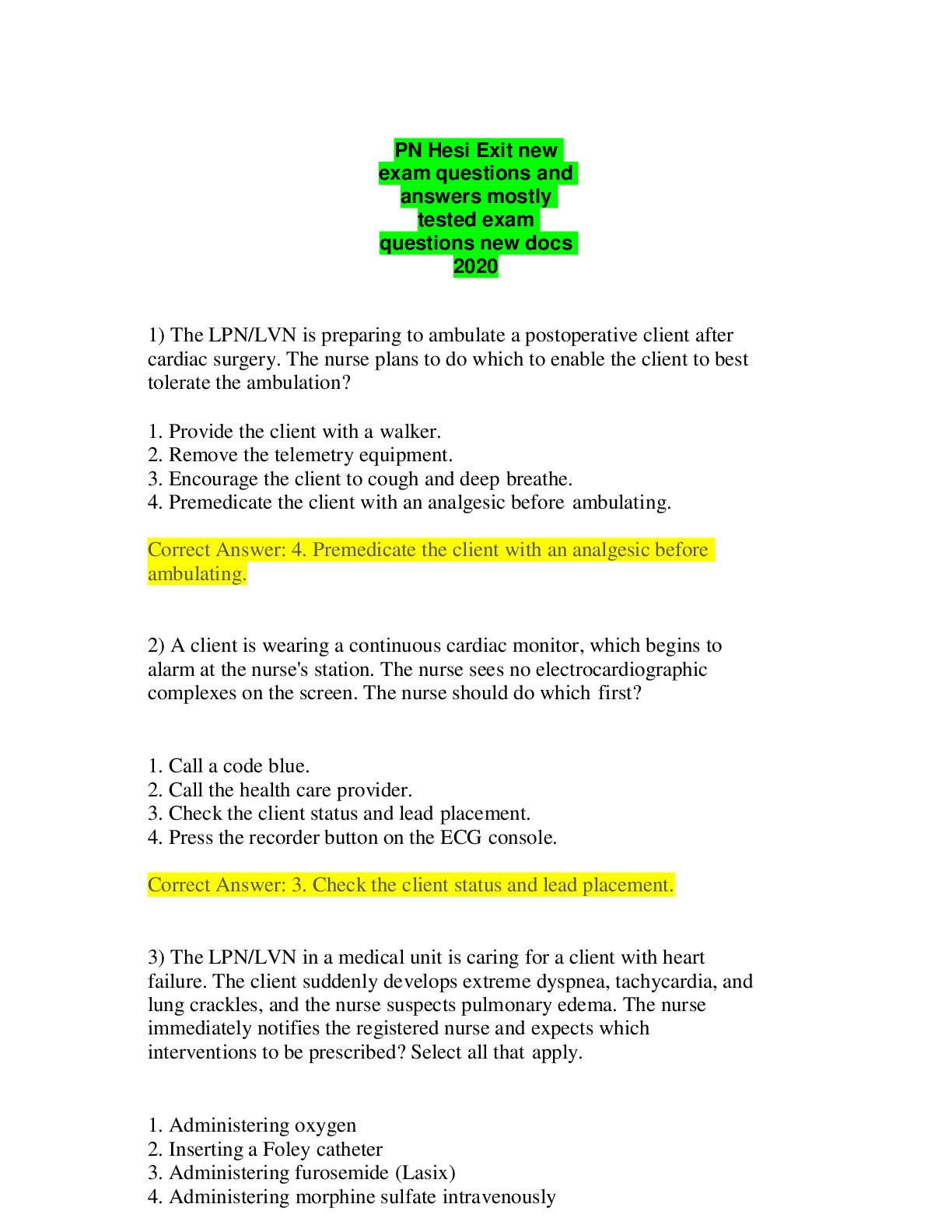
Reviews( 0 )
Document information
Connected school, study & course
About the document
Uploaded On
Dec 23, 2020
Number of pages
49
Written in
Additional information
This document has been written for:
Uploaded
Dec 23, 2020
Downloads
1
Views
95




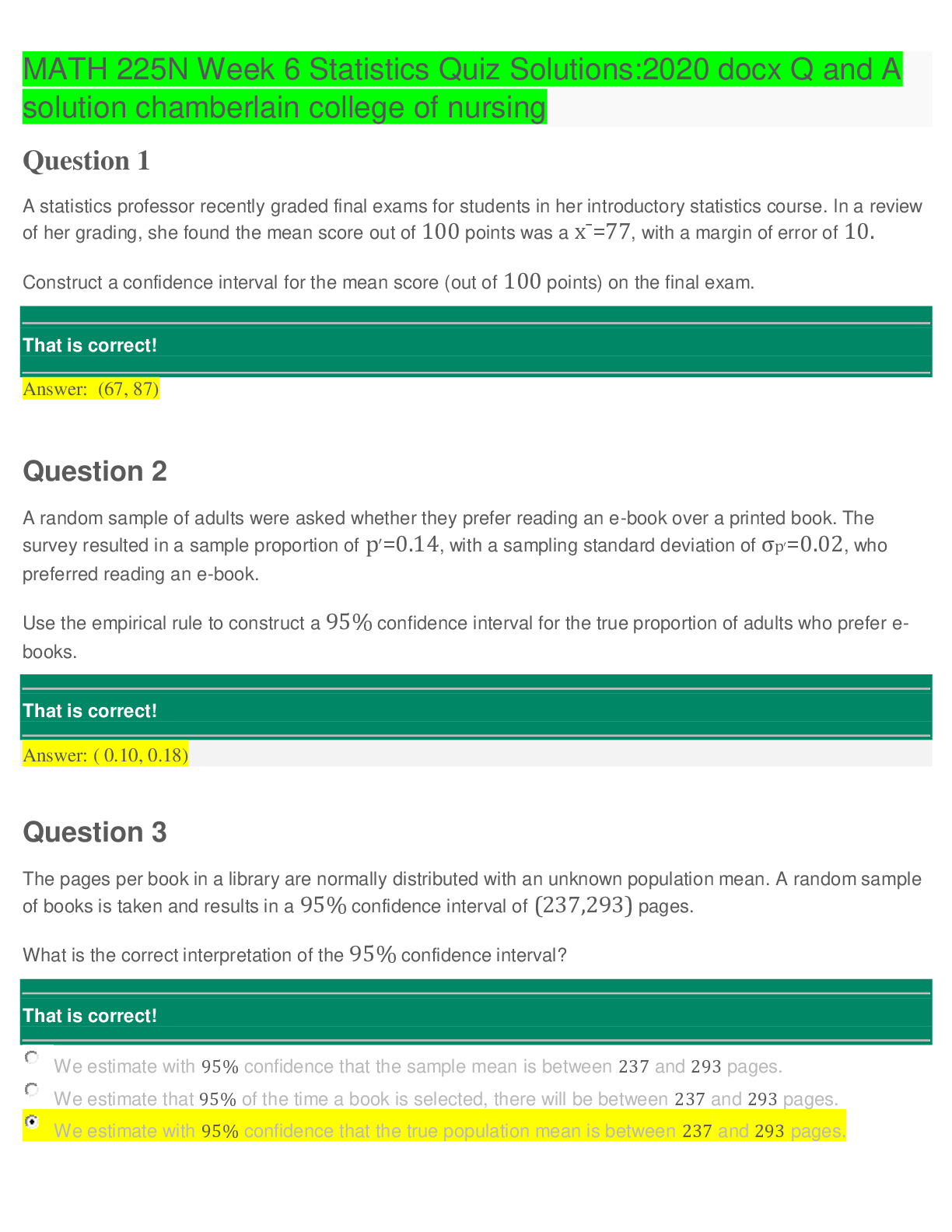

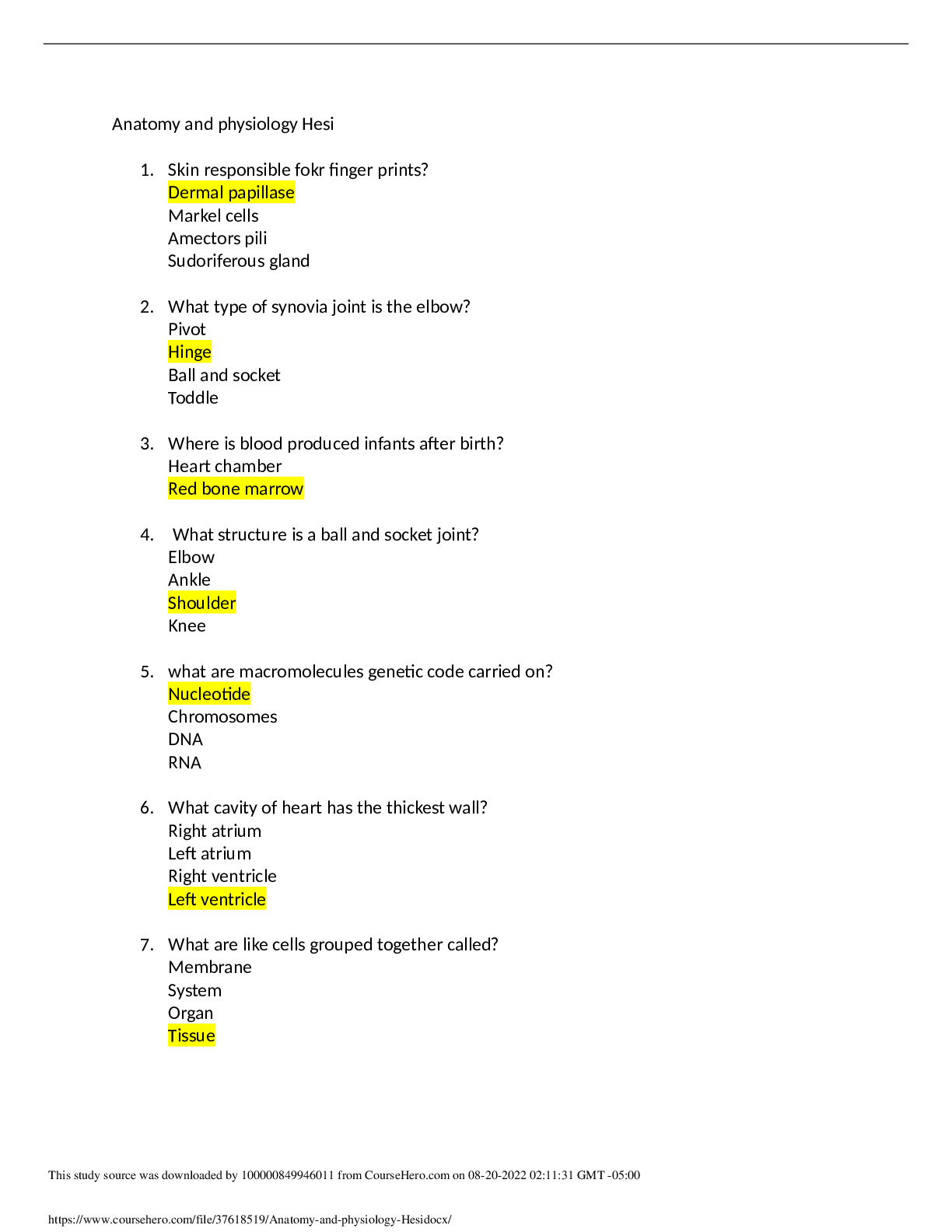

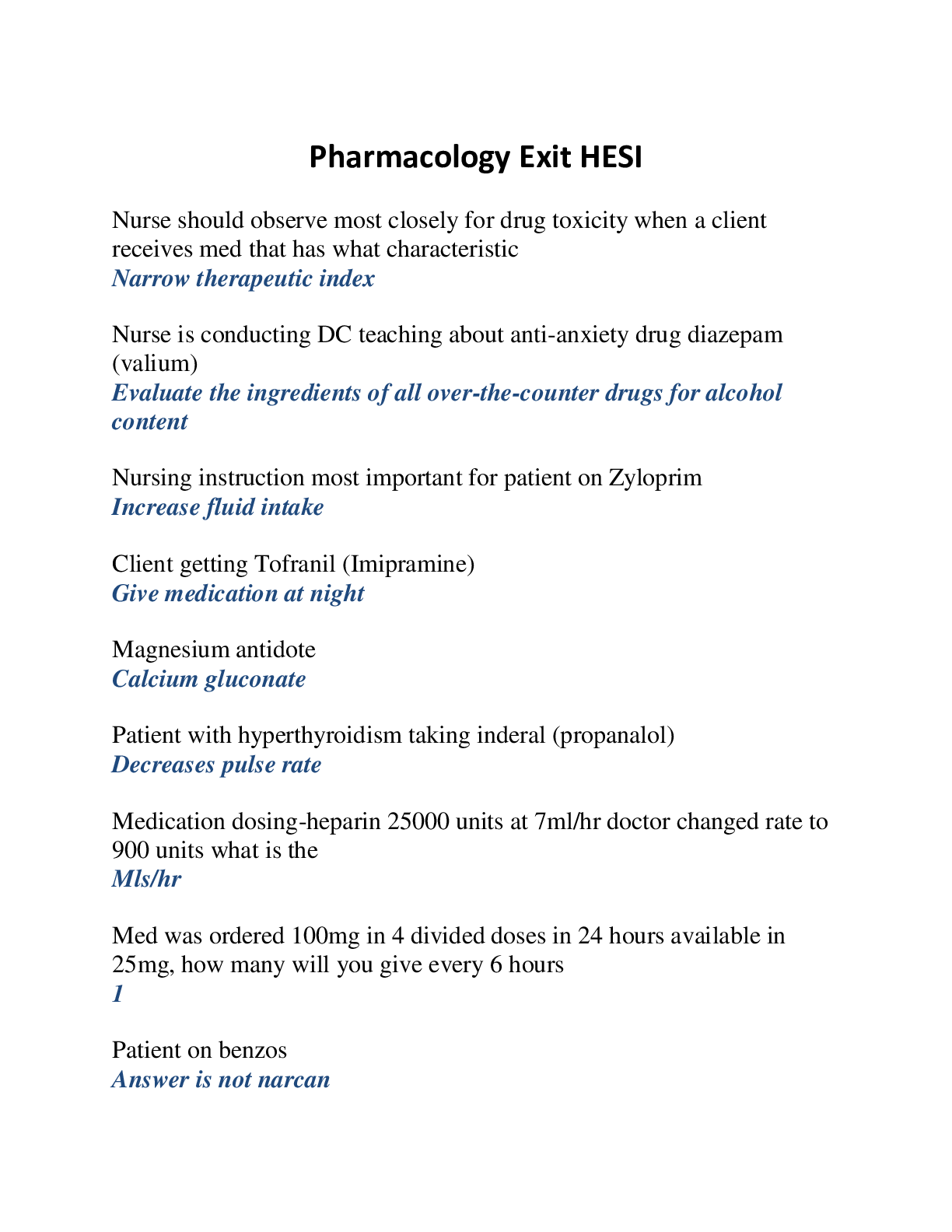
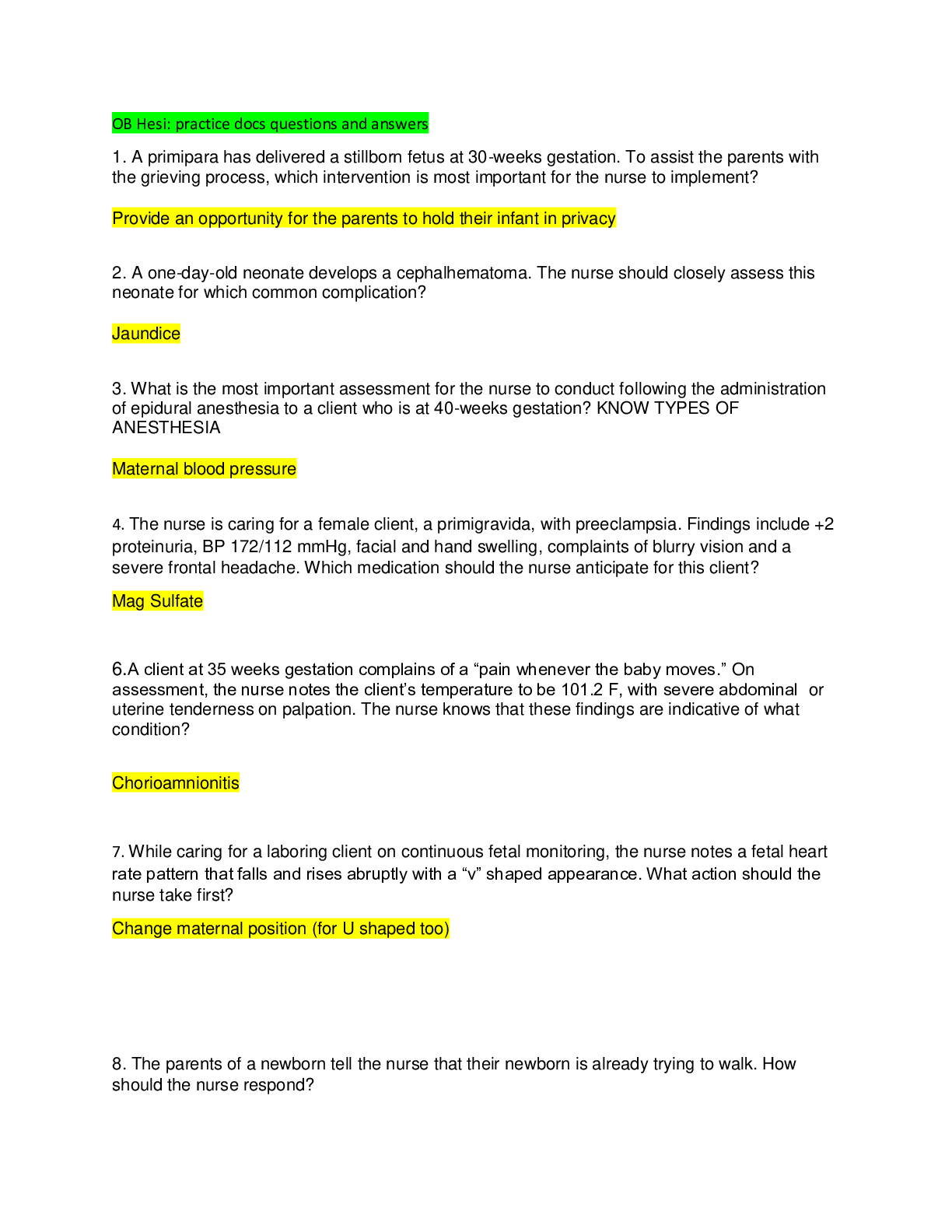
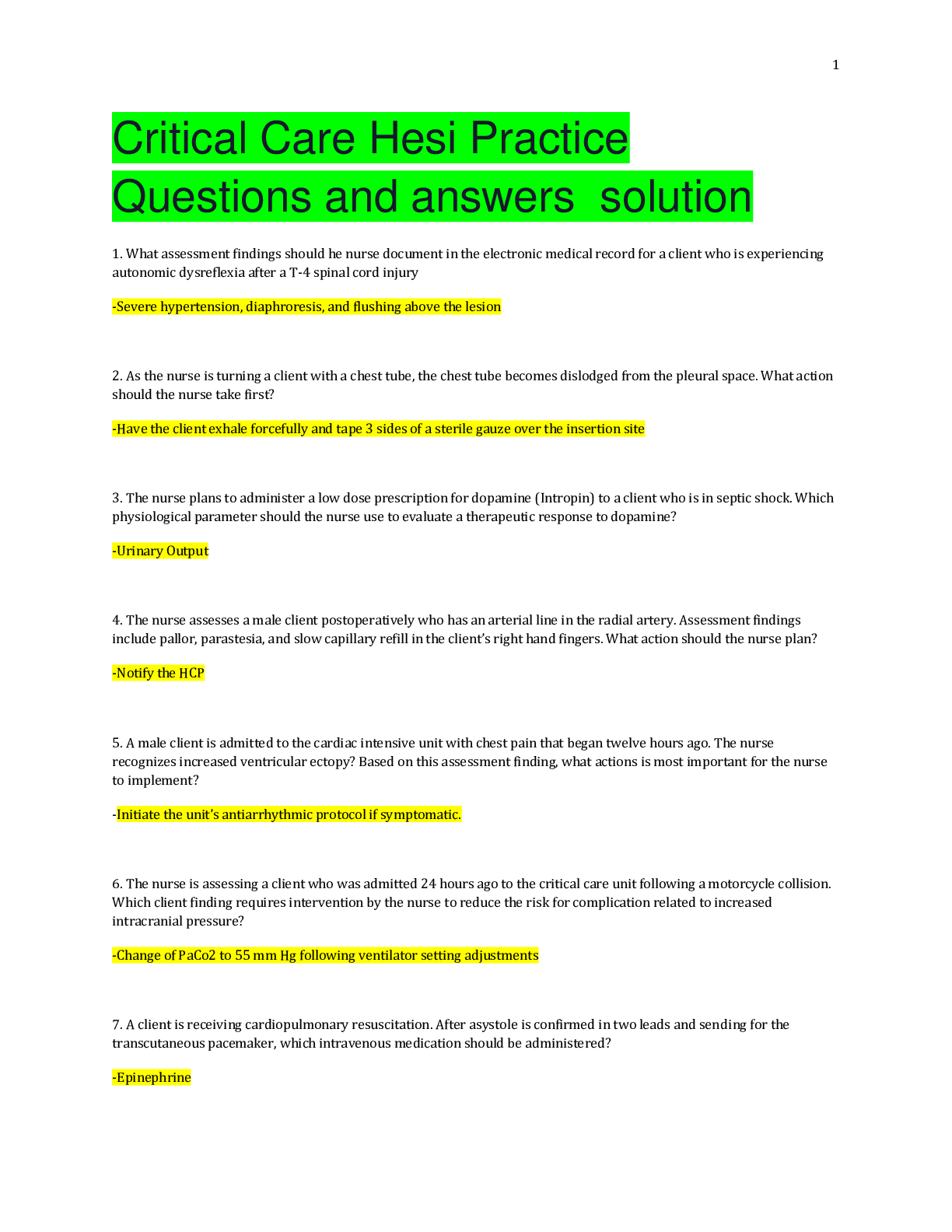
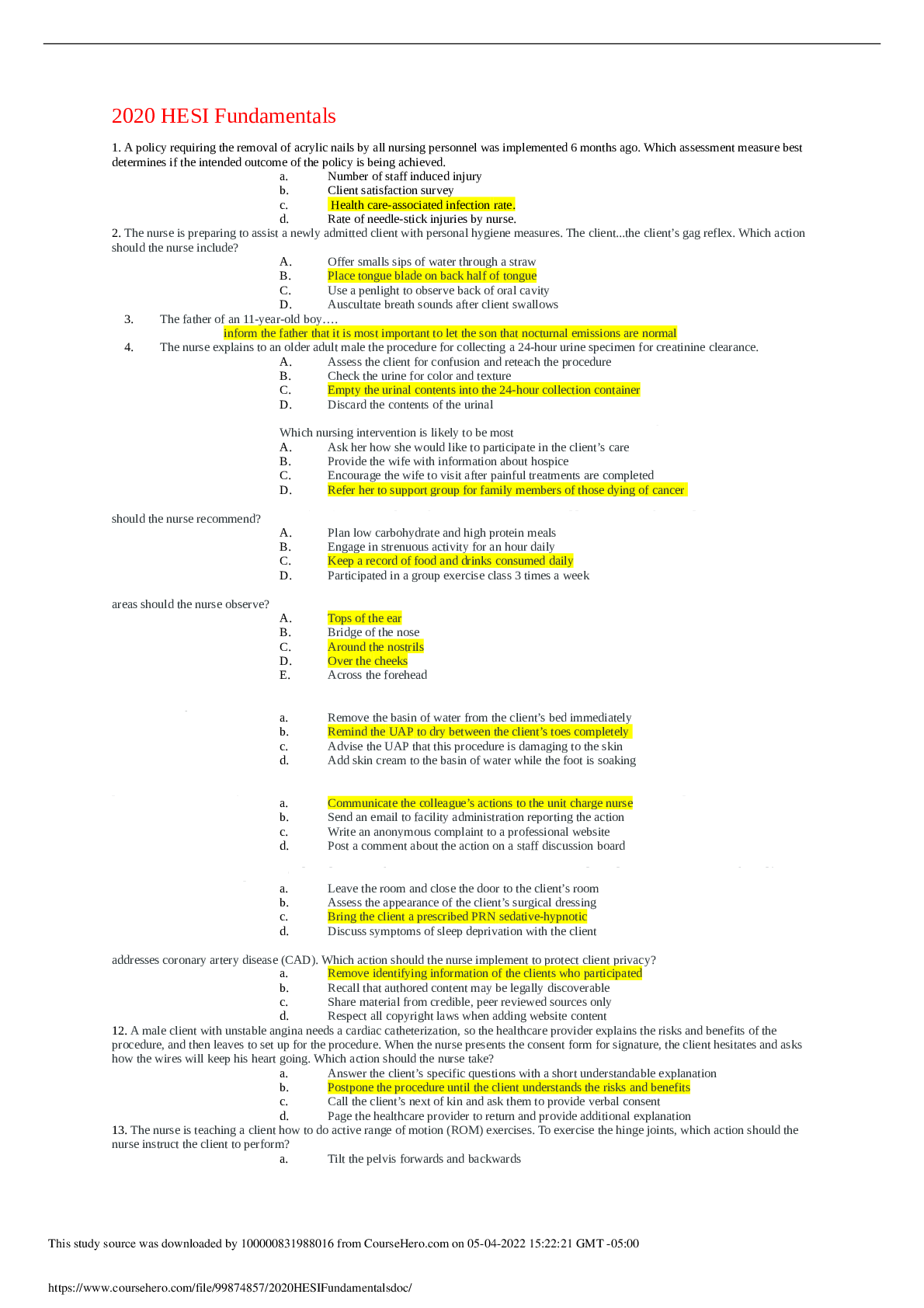

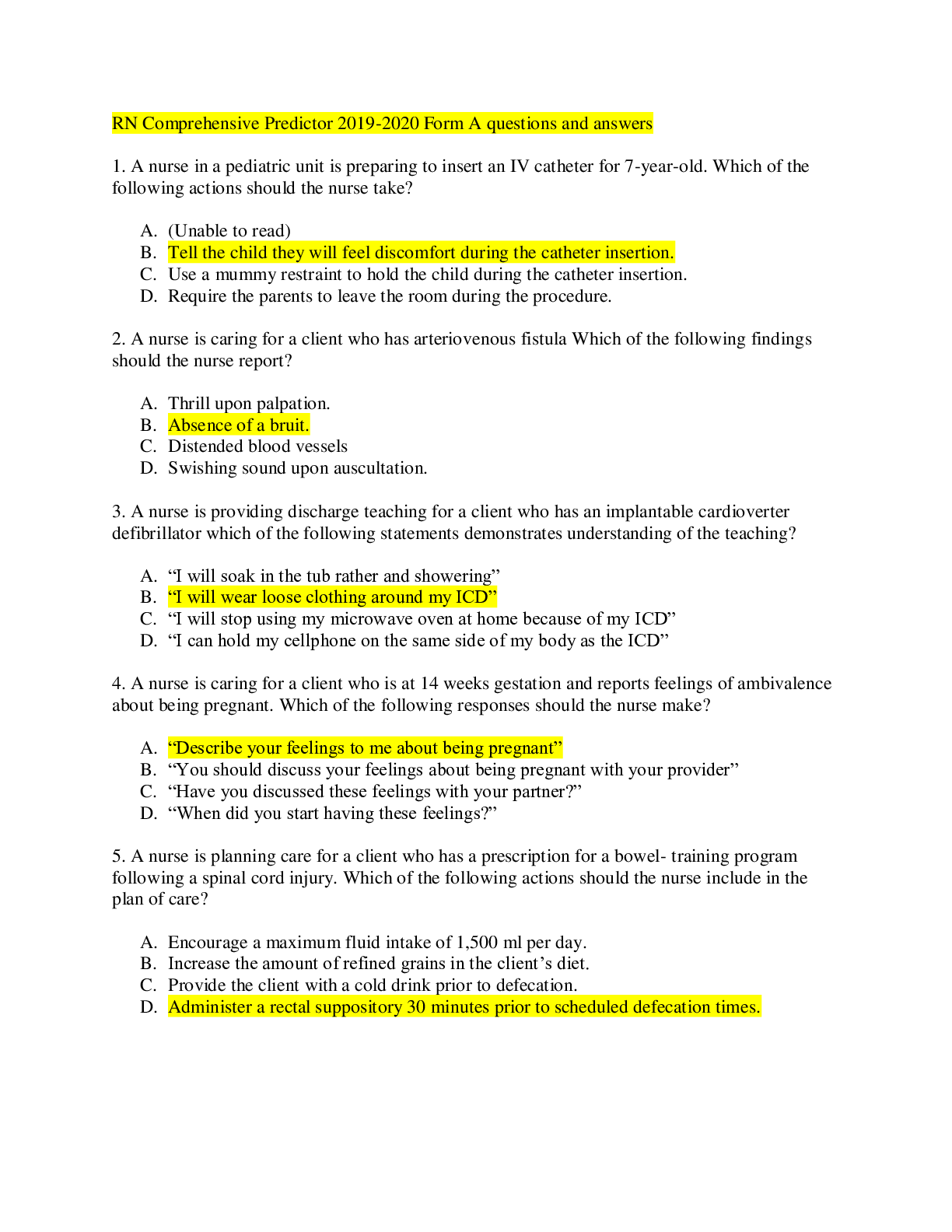

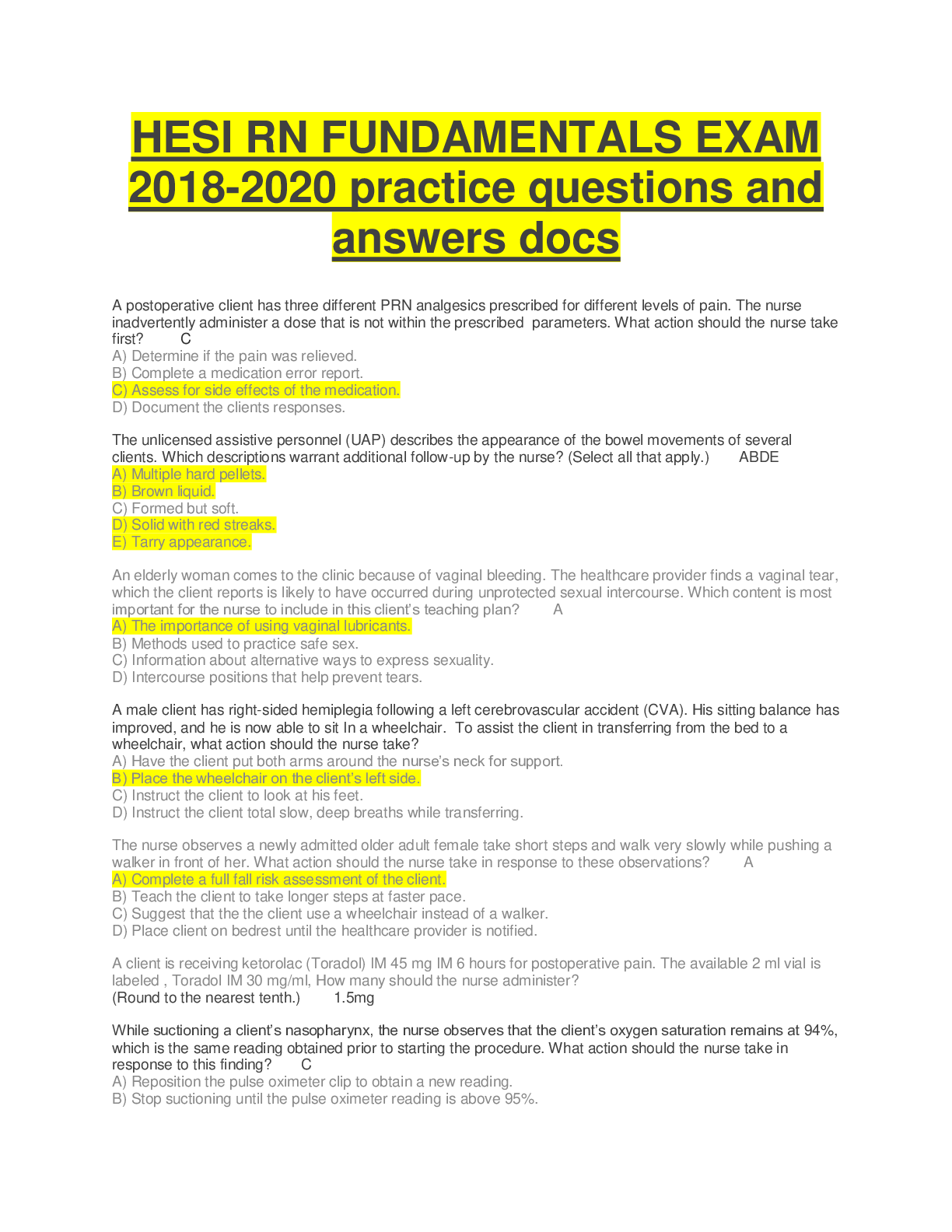
 2020 ans.png)

.png)
.png)

.png)
.png)



.png)
.png)
.png)
.png)
.png)



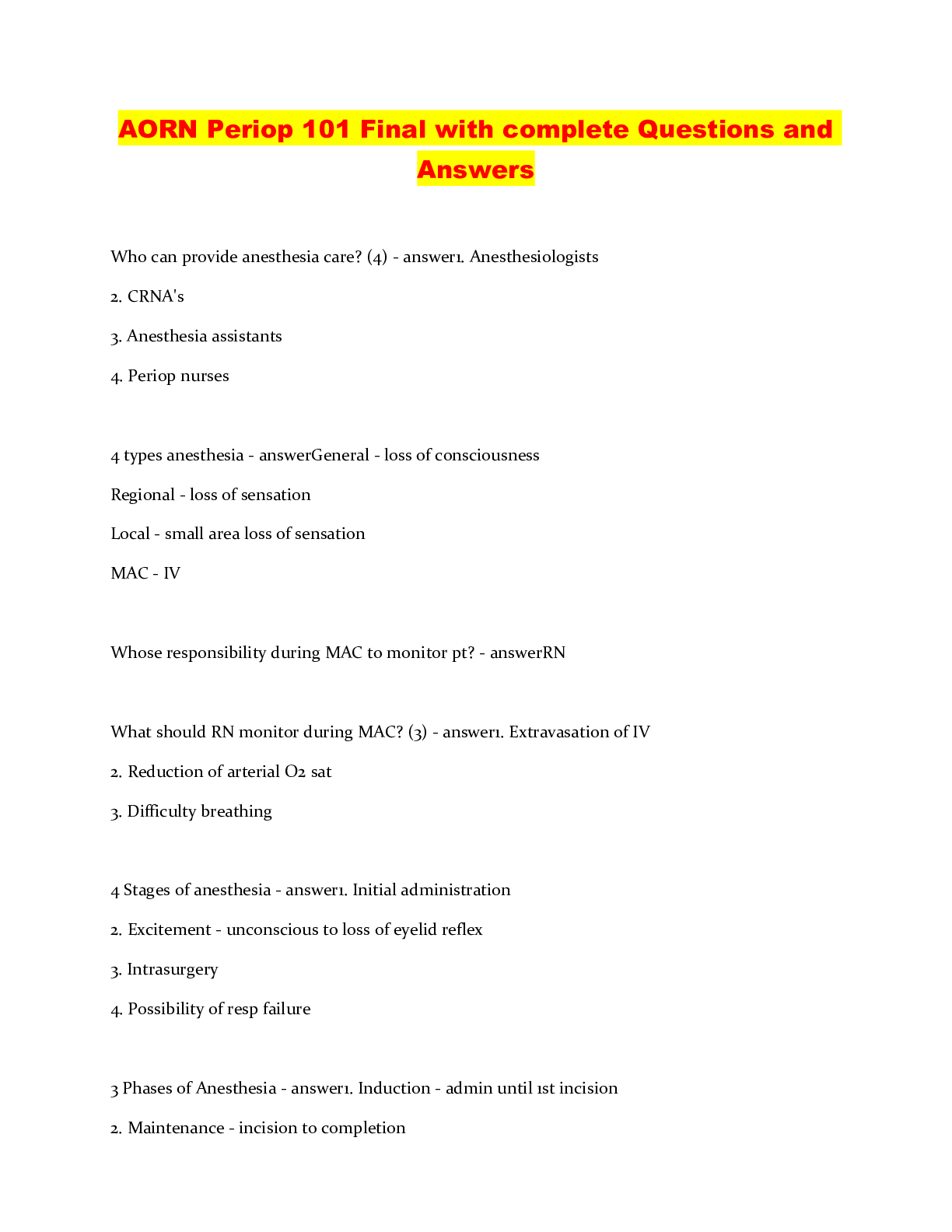
.png)
.png)

